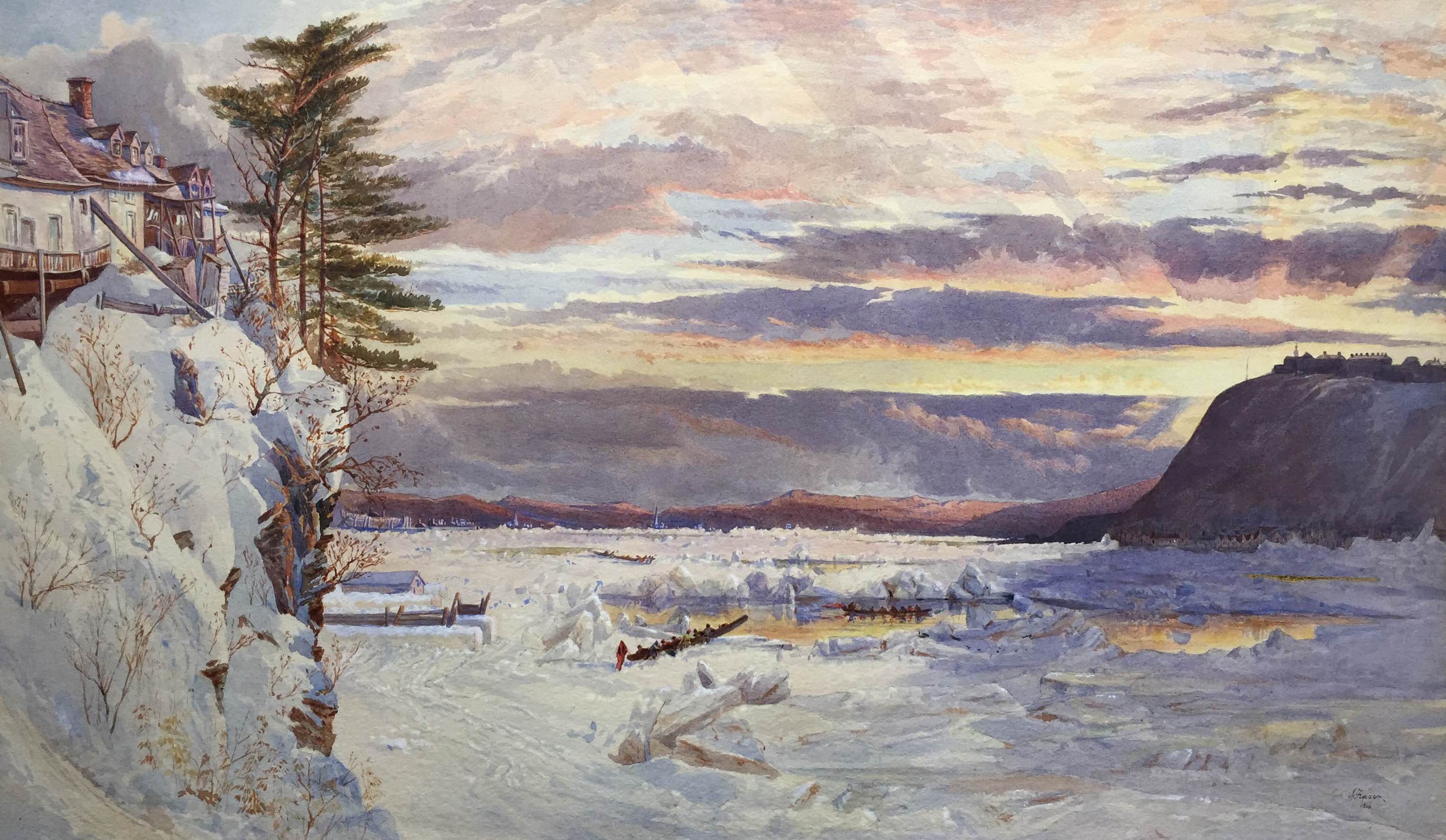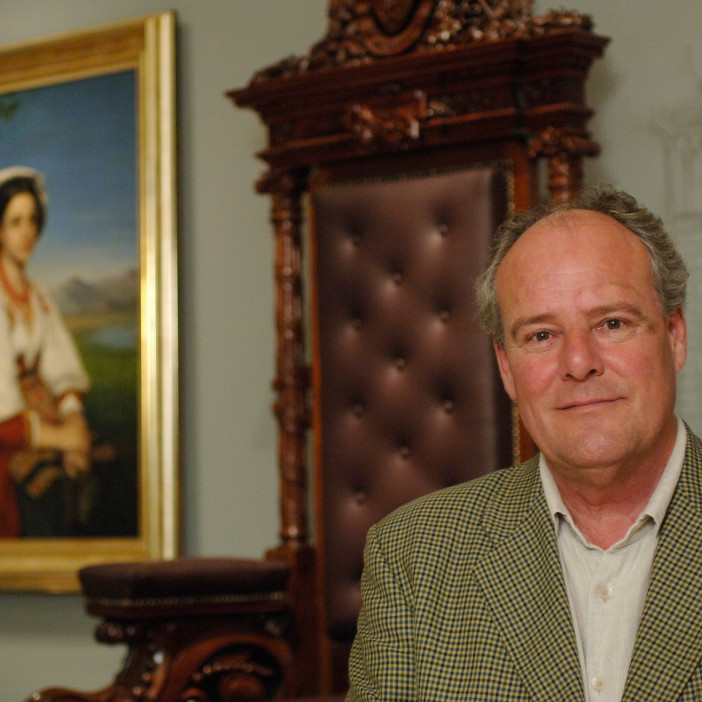"Remarkable" 19th Century Watercolour is One of Fraser's First Known Landscapes
From the Conquest until the end of the 19th Century, British landscape artists, professionals and military topographers travelled to the south shore of the Saint Lawrence River to take advantage of the magnificent view of Quebec. From the mouth of the Etchemin River at the west, to Pointe-Lévy at the east, painters and photographers have rendered many varying views of the Old City. Attracted by the Micmac settlements at Anse-aux-Sauvages, many artists have favoured Pointe-Lévy for the spectacular panoramic view it offers of the Capital, the Saint Lawrence River and the North Shore [1].

John Arthur Fraser, R.C.A., O.S.A. (1838-1898), Crossing the Ice from Pointe Lévis to Quebec, Spring, 1866, watercolour, 13 x 21 in.
This unique work is the only recorded view of the Quebec City area painted by John Arthur Fraser (1838-1898) who was renowned for his sumptuous landscapes of the Eastern Townships and the Rockies. Dated 1866, when Fraser was at the beginning of his Canadian career, this watercolour is also among the artist’s first known landscapes. Having studied in London at the Royal Academy of Arts and working as a portrait painter, 20-year old Fraser emigrated with his family to Canada. In 1860, he was hired by William Notman in Montreal to enhance with colour portraits taken by the famous photographer and became the first full-time artistic director of Notman Studios. He soon became known as one of the most talented colorists and watercolorists in the country [2].
By 1867 Fraser had registered at the first Salon of the American Society of Painters in Water Colours, held in New York City. In 1868, he partnered with Notman to open a studio in Toronto, which he directed until around 1880 when he embarked on a brilliant solo career as a landscape artist. During his career Fraser co-founded a number of important artistic societies, including the Art Association of Montreal, the Ontario Society of Artists and the Royal Canadian Academy of Arts).
For this winter scene, Fraser chose a most unusual, if not to say extremely rare view of the Quebec City area. The plein air composition is on three planes, directing the gaze upstream into the far distance, westward towards the setting sun behind Cap Diamant with the Citadelle and Officers’ Barracks towering above. Fraser paints the architectural profile of Lower Town at the base of the monumental and sombre rocky mass rather than showing the more typical silhouette of Upper Town and its characteristic public buildings. The fading light of sunset allows Fraser to capture the clouded sky in rich tones and with dramatic effect. In the foreground, on the left, above a rocky cliff, are evergreens and workers’ rustic homes. Behind them, scaffolding and outhouses are discernible. Lower down is the loading dock, likely for the old ice bridge and probably used as a launching ramp for the canoes, and next to that is a long hangar or boathouse to store them. Above this, one perceives the hull of a large ship in drydock, either under construction or under repair [3]. This part of the composition is rendered with the meticulous attention to detail of a miniaturist. In the middle-ground, in the center of the painting, Fraser depicts the ice-crossing in canoes, the true subject of this composition. During the spring thaw, when the ice bridge between the two shorelines becomes unsafe, residents and travellers crossed the river in canoes from the train stations at Quebec or Lévis: a slow and precarious obstacle course between ice-jams, breakups and pools of water [4].
This refined work recalls the photographic realism in which Fraser worked with Notman. He offers less of a topographic view of the Capital or of Lévis than an ethnographic one, picturesque and romantic, as would have appealed to the popular taste of the times. This unique piece of remarkable quality is definitely critical to understanding John Arthur Fraser’s oeuvre and particularly his early work as a landscape artist. It testifies to this eminent painter’s indubitable sensitivity and mastery of watercolour, revealing that by 1866 he was already a most accomplished artist.
© This text has been translated from its original version in French and is protected by Copyright.
We thank Dr. Mario Béland for this appreciation.
Dr. Béland recently retired as the Curator of Old Master Art after a distinguished 30 year career at the Musée national des beaux-arts du Québec (MNBAQ). During that time, he curated 40 exhibitions and published numerous papers and other communications. His research projects into Canadian sculpture and painting are known for their quality, rigor and passion, as are his artist monographs - including Louis Jobin and Eugene Hamel - and his reference books. In 2014 the Société des musées québécois (Quebec Society of Museums) honoured Dr. Béland with the Career Excellence Award for his outstanding achievements and contributions to the advancement of Quebec museology. Mario Béland holds a Ph.D. in art history from the Université de Laval in Québec.
________________
References:
Mentioned, in chronological order: Richard Short, James Peachy, George Heriot, Charles Ramus Forrest, Robert Auchmuty Sproule, James Pattison Cockburn, Henry William Barnard, James Hope Wallace, George Seton, Fred H. Holloway, Cornelius Krieghoff, Lucius O’Brien. See John R. PORTER and Didier PRIOUL, Québec, plein la vue, Québec, Musée du Québec/Les Publications du Québec, 1994, 299 p.
The portraits signed Fraser & Notman in Montreal are held at the McCord Museum in Montreal, at Library and Archives Canada and at the National Gallery of Canada in Ottawa. The McCord Museum also holds several photographic portraits of Fraser and members of his family, among which one of the artist dated 1866. Until the discovery of this view of Quebec, the earliest known landscapes by Fraser were dated the end of the 1860’s except for Sunshine and Shower, reproduced in 1863 in Photographic Selections... by William Notman, and three watercolours, one of which was Owl’s Head, a sketch which Fraser presented in 1864 and 1865 at the AAM - but all these works have since disappeared. In 1868, Fraser, then in Toronto, presented a painting entitled Kamouraska which also dates no doubt to this trip to the Quebec City area. On Fraser, see Dennis REID, « Our Own Country Canada: Being an Account of the National Aspirations of the Principal Landscape Artists in Montreal and Toronto 1860-1890, Ottawa, National Gallery of Canada, 1979, 453 p.; the entry by Dennis REID, “Fraser, John Arthur”, in Dictionary of Canadian Biography, vol.12, University of Toronto/Université Laval, 2003, http://www.biographi.ca/en/bio/fraser_john_arthur_12E.html as well as the catalogue by Kathryn L. KOLLAR, John Arthur Fraser, 1838-1898. Watercolours, Montreal, Concordia Art Gallery, 1984, 64 p. The author defended her master’s thesis at Concordia University in 1981. Read the commentary cited by Reid (1979) in the margin of the reproduced copy of Sunshine and Showers, 1863 (p. 46): This is one of the few landscapes that the artist has produced since in Canada. His practice is to paint in the open air, direct from Nature, and many of his sketches are faithfully transcribed from particular spots. There is a freshness and natural tone about them that makes us regret he has not had more opportunity of following a branch of art in which he would be successful. As director of the artistic department of Notman Studios, Fraser exerted a strong influence on his employees, among whom and one of his best students, Henry Sandham.
A similar escarpment is depicted in View of Quebec by William F. Wilson, dated 1851 and held at the McCord Museum. See PORTER and PRIOUL, op. cit., p. 134. Writings about the fort at Levis and dated 1864-65, show three shipyards in the northeast section of Glenburnie Cove at Lauzon: the shipyards of St.Lawrence Towboat, Charland & Marquis, and Duncan Patton. Also of note, a bit further west, are the sites of Dubord, Davie and Saint-Lawrence Cove. The distant details are more imagination than reality, probably to make the whole appear more picturesque. In 1866, the South Shore after Lévis towards the west was hardly developed and in fact, the shoreline of the South and the North Shores has changed greatly since then. It is also difficult to determine which church steeples are depicted at shore level where the bridge is now erected, The church of Notre-Dame-de-Levis is built higher up and Saint-Romuald was close to the river in 1855-57. Towards the right, on the North Shore, Saint-Michel-de-Sillery is missing although it was built in 1852. Finally, still heading west towards Montreal, the watercolour does not show the waters which flow into the estuary, and makes it look as if this were a bay surrounded by a chain of mountains.
The exotic scenes of the Saint Lawrence canoe ice-crossings piqued the interest of many foreign artists. Examples can be found in the watercolours of George St. Vincent Whitmore, in 1836 (Library and Archives Canada), of Philip John Bainbrigge, in 1837 (Musée national des beaux-arts du Québec, Québec and Royal Ontario Museum, Toronto), and of Denis Gale, around 1860 (Library and Archives Canada). Also of great note are the paintings of Cornelius Krieghoff whose famous Passengers and Mail, Crossing the RIver (private collection) shows how the Royal Mail was delivered and inspired a lithograph published in 1860 by John Weale in London. As late as 1912, Eugène Hamel also incorporates the same theme in his watercolours.







Comments
Grand merci M. Béland pour cette analyse vraiment fort intéressante.
Et aussi pour toutes vos références, qui sont autant de clés pour ouvrir des portes pour la recherche.
Cordiales salutations,
Richard Lavoie, M.A., ethnologue
et praticien en archéologie historique
Auteur du livre Naviguer en canot à glace, un patrimoine immatériel.
Add a comment